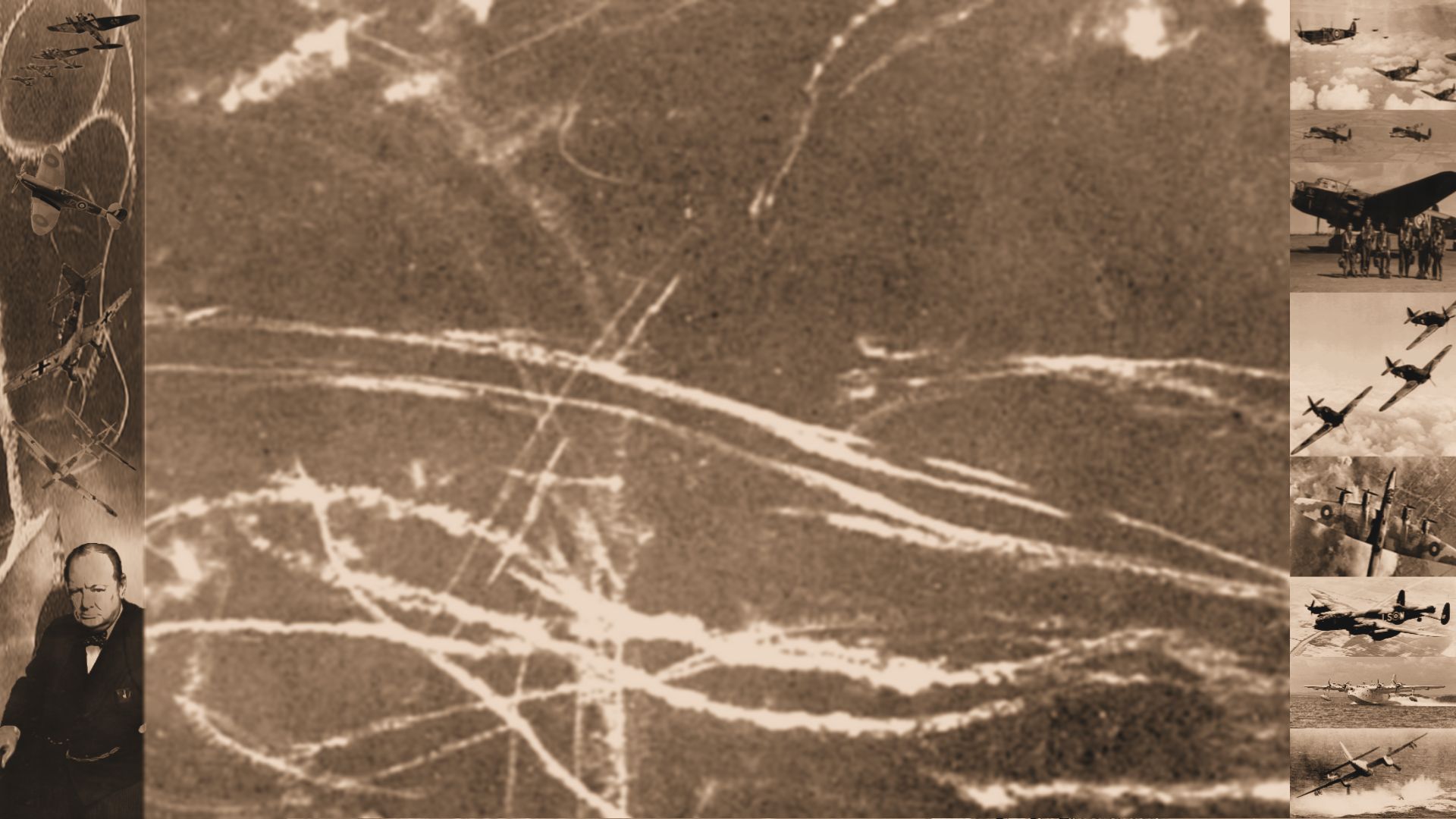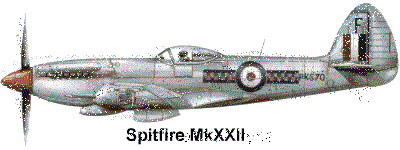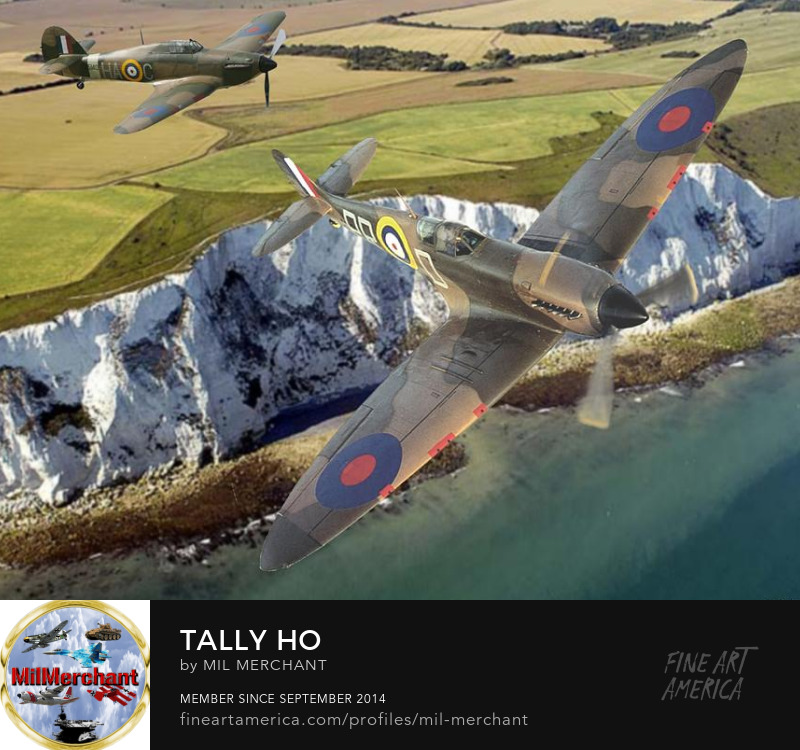The Supermarine Spitfire was Britain's premiere fighter throughout the entire war. Pilots found it to be agile and dependable, it was a fine air-combat plane capable of great speed and superior high-altitude performance. It was continuously upgraded so that it would match or better the best German fighters at the time. Only until late in the war when jet aircraft appeared was the Spitfire made obsolete, although even then, pilots in Spitfires shot down Messerschmitt Me262 jets. It even served aboard aircraft carriers as the 'Seafire'.
Development
The Spitfire was developed by Sir Reginald Mitchell through the 1930's military competitions to replace the Bristol Bulldog fighters. It was named 'Spitfire' and it went in production in 1938 as the Mk.I version. It was powered by the Rolls-Royce Merlin II of 1030 hp. This gave the Mk I a speed of 355 mph, a climb rate of 2515 ft/min, and a vey high ceiling of 34,556 ft. It came equipped with no fewer than 8 0.3.3 Vickers K machine guns, 4 in each wing. A total of 1583 Mk.Is were made. Many more versions followed that saw continual modifications to the Merlin engine to extract more power from it. The original cockpit suffered from a rear-ward vision problem, it was eventually replaced with a Miles M.20 similar to the design for the P-51D 'Mustang'. The Miles M.20 preceded the Mustang's bubble canopy by four years in 1940. The propeller changed from a two-bladed wooden one to a steel 5-bladed propeller. The armament increased from eight machine guns to four cannons and bombs. When the Merlin engine reached its limit in 1942 (its power had increased from 990 hp to 1,730 hp), Supermarine turned to the Rolls-Royce Griffon engine. A very successful version of the Spitfire (Mk XIV) was a Mk.VII with a five-bladed propeller and a Griffon engine. With the Mk.21 variant a new name, the "Victor" had been proposed, but not adopted. This aircraft was superior to almost all German fighters, except the last version of the Ta152. The last version, the Mk.22, was armed with four 20 mm cannons and had a very powerful engine capable of catching V1 rockets.
Back to Top
Variants
There were 24 marks of Spitfire and many sub-variants. These covered the Spitfire in development from the Merlin to Griffon engines, the high-speed photo-reconnaissance variants and the different wing configurations. More Spitfire Mk Vs were built than any other type, with 6,487 built, followed by the 5,656 Mk IXs. Of the MkV series, only 94 MkVAs were made with 3,923 MkVBs produced and 2,447 MkVCs produced. Different wings, featuring a variety of weapons, were fitted to most marks; the A wing used eight .303 in (7.7 mm) machine guns, the B wing had four .303 in (7.7 mm) machine guns and two 20 mm (.79 in) Hispano cannon, and the C or Universal Wing could mount either four 20 mm (.79 in) cannon or two 20 mm (.79 in) and four .303 in (7.7 mm) machine guns. As the war progressed, the C wing became more common. Two types of wing were adopted, a standard one (known as the F wing) and a clipped version (the LF wing) that had better performance at lower altitudes. The armament became more diverse, varying from eight machine guns in the MkVA, the four machine guns and two cannons in the MkVB and the four cannons in the MkVC. Another armament variation was the E wing which housed two 20 mm (.79 in) cannon and two .50 in (12.7 mm) Browning machine guns. The last version, the Mk.XXII used the same Griffon engine as the Mk XIV with a speed of 425 mph, but it had an increased range of 567 miles. It carried heavier armament, using four 20 mm British-Hispano cannons with 200 rounds each. A total of 278 Mk.22s were built. Although the original airframe was designed to be powered by a Rolls-Royce Merlin engine producing 1,030 hp (768 kW), it was adaptable enough to use increasingly powerful Merlin and later Rolls-Royce Griffon engines producing up to 2,035 hp (1,520 kW).
Back to Top
Royal Navy version
The Seafire, a name derived from Sea Spitfire, was a naval version of the Spitfire specially adapted for operation from aircraft carriers. Although the Spitfire was not designed for the rough-and-tumble of carrier-deck operations, it was considered to be the best available fighter at the time, and went on to serve with distinction. The basic Spitfire design did impose some limitations on the use of the aircraft as a carrier-based fighter; poor visibility over the nose, for example, meant that pilots had to be trained to land with their heads out of the cockpit and looking alongside the port cowling of their Seafire also, like the Spitfire, the Seafire had a relatively narrow undercarriage track, which meant that it was not ideally suited to deck operations. Another problem it has was limited range, leaving the Seafire usually to perform CAP(Combat Air Patrol) operations.
Back to Top
In Action
Upon entering RAF service, they were distributed amonst the squadrons of 11th Group RAF which bore the brunt of the Luftwaffe aerial assault in the Battle of Britain. When in Germans launched their Blitzkreig in the west, Air Marshall Dowding refused to send Spitfires to support the French, though he sent other RAF units including Hurricane and Fairey Battle squadrons. However, Spitfires did fight over Dunkirk during the evacuation keeping the Luftwaffe at bay. They were on par with the Bf109s in the Battle of Britain. The Mark II arrived just at the end of the battle and were the first to fly back over the Continent in 1941. Again, the Luftwaffe matched its improvement with their Bf109F variant also arriving at the same time. The Spitfire MkV was a compromise between performance, flexibility of use and firepower. They began to arrive at front line units in March 1941. On the arrival of the Fw 190, the Spitfire MkV was completely outclassed. It wasnt until the Mark IX became operational before parity was again acheived. The VC version used a universal wing capable of fitting all of the armament variations. The engines used were the Merlin 45 and 50, generating 1,440 and 1,490 hp, respectively. After the Battle of Britain, the Spitfire became the backbone of RAF Fighter Command, and saw action in the European, Mediterranean, Pacific and the South-East Asian theatres. Much loved by its pilots, the Spitfire served in several roles, including interceptor, photo-reconnaissance, fighter-bomber, carrier-based fighter, and trainer. It was built in many variants, using several wing configurations.
A total of 20,531 Spitfires in 40 modifications were built. It remained in service with various airforces for many years after the end of the war and the Seafire naval variation was last used in combat by the Royal Navy from the carrier HMS Triumph in the Korean war.
Back to Top




